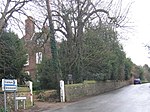Singlewell Infrastructure Maintenance Depot
England rail transport stubsRailway depots in EnglandUse British English from March 2017

The Singlewell Infrastructure Maintenance Depot is a railway maintenance depot located near the Gravesend ward of Singlewell, Kent, in the United Kingdom. The depot is located between the A2 road and High Speed 1 (Channel Tunnel Rail Link). It lies halfway between Ebbsfleet International railway station and the Medway Viaducts, and is connected via a spur at the Singlewell freight loops. When originally constructed in 2007, the area between the A2 and the depot formed a field, but the subsequent long-planned realignment of the A2 meant that the road now runs closer to the depot. The depot has fuelling facilities, workshops, plant storage and offices.
Excerpt from the Wikipedia article Singlewell Infrastructure Maintenance Depot (License: CC BY-SA 3.0, Authors, Images).Singlewell Infrastructure Maintenance Depot
Watling Street, Gravesham Cobham
Geographical coordinates (GPS) Address Nearby Places Show on map
Geographical coordinates (GPS)
| Latitude | Longitude |
|---|---|
| N 51.408 ° | E 0.382 ° |
Address
Watling Street
DA12 5UD Gravesham, Cobham
England, United Kingdom
Open on Google Maps








